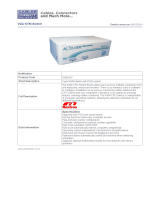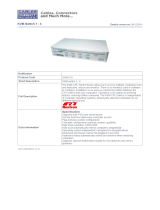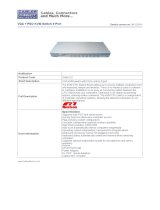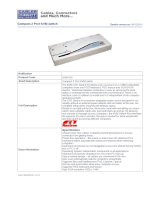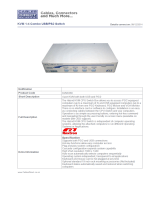Page is loading ...

10707 Stancliff Road Phone: (281) 933-7673
Houston, Texas 77099 WWW.ROSE.COM
VISTA KVM-SERIES
INSTALLATION AND OPERATIONS
MANUAL

LIMITED WARRANTY
Copyright Rose Electronics 1990-2001. All rights reserved.
No part of this manual may be reproduced, stored in a retrieval system, or
transcribed in any form or any means, electronic or mechanical, including
photocopying and recording, without the prior written permission of Rose
Electronics.
Rose Electronics Part # MAN-V8
Printed In the United States of America - Revision 2.0
Rose Electronics warrants the Vista™ to be in good working order for one year from the date of purchase
from Rose Electronics or an authorized dealer. Should this product fail to be in good working order at any
time during this one-year warranty period, Rose Electronics will, at its option, repair or replace the Unit as
set forth below. Repair parts and replacement units will be either reconditioned or new. All replaced parts
become the property of Rose Electronics. This limited warranty is valid only if repairs are performed by
Rose Electronics or a Rose qualified service technician. This limited warranty is void if repairs are not
performed by Rose Electronics or a Rose qualified service technician. This limited warranty does not
include service to repair damage to the Unit resulting from accident, disaster, abuse, or unauthorized
modification of the Unit, including static discharge and power surges.
Limited Warranty service may be obtained by delivering this unit during the one-year warranty
period to Rose Electronics or an authorized repair center providing a proof of purchase date. If this
Unit is delivered by mail, you agree to insure the Unit or assume the risk of loss or damage in
transit, to prepay shipping charges to the warranty service location, and to use the original shipping
container or its equivalent. You must call for a return authorization number first. Under no
circumstances will a unit be accepted without a return authorization number. Contact an authorized
repair center or Rose Electronics for further information.
ALL EXPRESS AND IMPLIED WARRANTIES FOR THIS PRODUCT INCLUDING THE
WARRANTIES OF MERCHANTABILITY AND FITNESS FOR A PARTICULAR PURPOSE, ARE
LIMITED IN DURATION TO A PERIOD OF ONE YEAR FROM THE DATE OF PURCHASE, AND
NO WARRANTIES, WHETHER EXPRESS OR IMPLIED, WILL APPLY AFTER THIS PERIOD.
SOME STATES DO NOT ALLOW LIMITATIONS ON HOW LONG AN IMPLIED WARRANTY
LASTS, SO THE ABOVE LIMITATION MAY NOT APPLY TO YOU.
IF THIS PRODUCT IS NOT IN GOOD WORKING ORDER AS WARRANTIED ABOVE, YOUR
SOLE REMEDY SHALL BE REPLACEMENT OR REPAIR AS PROVIDED ABOVE. IN NO EVENT
WILL ROSE ELECTRONICS BE LIABLE TO YOU FOR ANY DAMAGES INCLUDING ANY LOST
PROFITS, LOST SAVINGS OR OTHER INCIDENTAL OR CONSEQUENTIAL DAMAGES
ARISING OUT OF THE USE OF OR THE INABILITY TO USE SUCH PRODUCT, EVEN IF ROSE
ELECTRONICS OR AN AUTHORIZED DEALER HAS BEEN ADVISED OF THE POSSIBILITY OF
SUCH DAMAGES, OR FOR ANY CLAIM BY ANY OTHER PARTY.
SOME STATES DO NOT ALLOW THE EXCLUSION OR LIMITATION OF INCIDENTAL OR
CONSEQUENTIAL DAMAGES FOR CONSUMER PRODUCTS, SO THE ABOVE MAY NOT
APPLY TO YOU. THIS WARRANTY GIVES YOU SPECIFIC LEGAL RIGHTS AND YOU MAY
ALSO HAVE OTHER RIGHTS, WHICH MAY VARY FROM STATE TO STATE.
NOTE: This equipment has been tested and found to comply with the limits for a Class A digital
device, pursuant to Part 15 of the FCC Rules. These limits are designed to provide reasonable
protection against harmful interference when the equipment is operated in a commercial
environment. This equipment generates, uses, and can radiate radio frequency energy and, if not
installed and used in accordance with the instruction manual, may cause harmful interference to
radio communications. Operation of this equipment in a residential area is likely to cause harmful
interference in which case the user will be required to correct the interference at his own expense.
IBM, AT, and PS/2 are trademarks of International Business Machines Corp. Microsoft and
Microsoft Windows are registered trademarks of Microsoft Corp. Any other trademarks mentioned
in this manual are acknowledged to be the property of the trademark owner.

FCC/IC STATEMENTS, EU DECLARATION OF CONFORMITY
FEDERAL COMMUNICATIONS COMMISSION AND INDUSTRY CANADA
RADIO-FREQUENCY INTERFERENCE STATEMENTS
This equipment generates, uses and can radiate radio frequency energy
and if not installed and used properly, that is in strict accordance with the
manufacturer’s instructions may cause interference to radio
communication. It has been tested and found to comply with the limits for
a Class B digital device in accordance with the specifications of Part 15 of
FCC rules, which are designed to provide reasonable protection against
such interference when the equipment is operated in a commercial
environment. Operation of this equipment in a residential area is likely to
cause interference, in which case the user at his own expense will be
required to take whatever measures may be necessary to correct the
interference.
Changes or modifications not expressly approved by the party responsible
for compliance could void the user’s authority to operate the equipment.
This digital apparatus does not exceed the Class A limits for radio noise
emission from digital apparatus set out in the Radio Interference
Regulation of Industry Canada.
Le présent appareil numérique n’émet pas de bruits radioélectriques
dépassant les limites applicables aux appareils numériques de la classe A
prescrites dans le Règlement sur le brouillage radioélectrique publié par
Industrie Canada.
EUROPEAN UNION DECLARATION OF CONFORMITY
This equipment complies with the requirements of the European EMC
directive 89/336/EEC in respect of EN55022 (Class B), EN50082-1 and
EN60555-2 standards and the Low Voltage Directive.

TABLE OF CONTENTS
Contents
Disclaimer................................................................................................1
Introduction..............................................................................................1
Product Registration................................................................................2
Features..................................................................................................2
Compatibility.......................................................................................3
System overview......................................................................................4
KVM station........................................................................................4
CPU connections................................................................................4
Rose Electronics web site...................................................................5
Vista KVM-Series models.........................................................................6
Installation...............................................................................................9
Step 1 - Connecting the KVM station...................................................9
Step 2 - Connect the CPUs ...............................................................10
Step 3 - Applying power....................................................................10
Step 4 – Verify keyboard, mouse and CPU operation........................10
Operating instructions............................................................................12
Keyboard command...............................................................................12
Keyboard command description........................................................14
KVM Flash Upgrade Utility.....................................................................17
TroubleShooting ....................................................................................20
Maintenance and repair.........................................................................22
Technical support...................................................................................22
Safety....................................................................................................23
Tables
Table 1. Compatibility...............................................................................3
Table 2. Front panel description...............................................................6
Table 3. Vista 2UPH/4UPH description....................................................7
Table 4. Vista 2PCA/4PCA description.....................................................8
Table 5. Keyboard commands................................................................13
Figures
Figure 1. Typical installation.....................................................................5
Figure 2. Vista 2 port................................................................................6
Figure 3. Vista 4 port................................................................................6
Figure 4. Vista to KVM station..................................................................9
Figure 5. Vista to CPU's.........................................................................10
Figure 6. Vista to CrystalView................................................................11
Appendix
Appendix A. Initial factory settings..........................................................26
Appendix B. Parts and cables................................................................27
Appendix C. General specifications........................................................28
Appendix D. Rack mount instructions.....................................................29
Appendix E. Rack mount illustration.......................................................29
Appendix F. Typematic rate...................................................................30

INTRODUCTION
Vista KVM-Series Installation and Operations Manual
1
Disclaimer
While every precaution has been taken in the preparation of this manual,
the manufacturer assumes no responsibility for errors or omissions.
Neither does the manufacturer assume any liability for damages resulting
from the use of the information contained herein. The manufacturer
reserves the right to change the specifications, functions, or circuitry of the
product without notice.
The manufacturer cannot accept liability for damages due to misuse of the
product or other circumstances outside the manufacturer’s control. The
manufacturer will not be responsible for any loss, damage, or injury arising
directly or indirectly from the use of this product.
Introduction
Thank you for choosing the Rose Electronics
Vista Personal KVM
switch. The Vista switch is the result of Rose Electronics commitment to
providing state-of-the-art switching solutions for today’s demanding work
place. The Vista switch has proven to be a valuable investment for users
that have a need to access multiple CPUs from a single KVM station.
Please refer to the safety section first before proceeding with any
installation or configuration of the Vista switch.
The Vista KVM-series switch is available in four models. The 2-port and 4-
port models are available with DB25 connectors or PC connectors.
For the Vista models with DB25 connectors, it is recommended that Rose
Electronics cable part number CAB-ZX0606Cnnn or CAB-CX0606Cnnn
(DB25 to HD15/PS2/PS2) CPU Cable be used.
For the models with PC connectors, it is recommended that Rose
Electronics cable part number CAB-CXV66MMnnn or CAB-ZX66MMnnn
(VGA/PS/2 keyboard/PS/2 mouse cable) be used.
The Vista switch can simplify your job by helping you organize your
multiple computer applications. Because the Vista switch lets you use a
single keyboard, video monitor, and mouse to access several computers,
you can significantly reduce your equipment overhead and end keyboard
and monitor clutter.
A
K
eyboard,
V
ideo monitor and
M
ouse are referred to
throughout this manual as a KVM station.

2
Vista KVM-Series Installation and Operations Manual
Product Registration
Take advantage of the following when you register your Rose Electronics
products online at www.rose.com/htm/warranty.htm:
§ Rose Standard Warranty Plus...
§ Free Lifetime Firmware Updates
§ Free Lifetime Technical Support
§ 30 Day Money Back Guarantee
§ Priority “First-in-Line” Status for Tech Support
Features
§ Available with DB25 or PC (keyboard, video monitor, mouse) CPU
connectors
§ Access up to 2 or 4 computers from one KVM station
§ Select a computer from the front panel or simple keyboard commands
§ Power is obtained from the attached CPUs, eliminating the need for an
external power source. An external power adapter can be used if using
a wireless keyboard and mouse
§ Front panel LEDs show status and selected CPU port
§ Keyboard, video monitor, and mouse plug directly into the unit
§ Scan mode automatically sequences through CPUs at adjustable rate
§ Non-volatile memory stores configuration settings
§ Full emulation of keyboard and mouse, allowing computers to be
booted at any time
§ Supports PS/2 mouse, wheel mouse, and serial mouse
§ Keyboard Num Lock, Caps Lock, and Scroll Lock states automatically
saved and restored when switching among CPUs
§ Keyboard mode is automatically detected for simultaneous support of
PCs, Unix computers, and IBM mode 1 computers
§ Reset button reinitializes all ports
§ Keyboard lockout function <Ctrl L>
§ Low cost and easy to use
§ Heavy-duty steel, fully shielded chassis
§ Rackmount option for 19", 23", or 24" racks (1 rack unit high, 1.75”)
§ Saves space, reduces equipment and power costs, and eliminates
clutter
§ Unlimited technical support
§ Made in USA

Vista KVM-Series Installation and Operations Manual
3
Compatibility
CPUs
Computers Industry standard PCs, Unix computers such as
RS-6000, HP 9000, SGI, DEC Alpha, MAC and others
Monitors SVGA
Keyboards PC PS/2, AT, PC and Apple USB
Mouse Standard PS/2 Mouse (2 or 3 button)
PC and Apple USB
Serial Mouse (2 or 3 button)
KVM Station
Monitors SVGA
Keyboards US, Korean, Japanese, keyboards with or without
Windows keys (101, 102, 104, 105, 106, 109 keys)
(Some older XT/AT auto-sensing keyboards may not
be compatible)
Mouse Standard PS/2 Mouse (2 or 3 button)
PS/2 Wheel Mouse (2 button + wheel)
PC and Apple USB
Serial Mouse (2 or 3 button)
Table 1. Compatibility
Package contents
The package contents consist of the following:
§ The Vista Unit
§ Power adapter (Optional)
§ Installation and operations manual
CPU cables are usually ordered separately. If the package contents are
not correct, contact Rose Electronics or your reseller so the problem can
be quickly resolved.

OVERVIEW
4
Vista KVM-Series Installation and Operations Manual
System overview
The Vista KVM-series switch is designed to provide seamless, trouble-free
switching from a single KVM station to any connected CPU. You can
switch to the connected computers by simple keyboard commands or
using the front panel buttons.
Figure 1 shows a typical configuration using the Vista 4 port switch with
DB25 connectors. Up to 4 CPUs can be connected to the Vista 4 port
switch and accessed from a single KVM station.
KVM station
A KVM station, consisting of a keyboard, video monitor and mouse,
connects directly to the Vista switches’ KVM connectors. The KVM station
can switch its keyboard, video monitor and mouse to any of the connected
CPUs and fully control that CPU if authorized. Files and folders can be
managed, applications can be executed, upgrades can be performed and
general maintenance done from the KVM station.
The keyboard, video monitor and mouse used for the KVM station should
be compatible with all of the CPU that will be connected. The KVM stations
mouse must be a PS/2 mouse. The Vista switch will translate PS/2 mouse
movements and present it in serial form to computers that use a serial
mouse The KVM connectors on the Vista switch are HD15F for the video
monitor and MiniDin-6F for the keyboard and mouse.
CPU connections
The CPU connectors on the Vista switch depend on the model ordered.
The “U” model connectors are DB25F for each CPU. The “PC” model
connectors are HD15F (video) and MiniDin-6F (keyboard and mouse) for
each CPU. Attached CPUs that use a serial mouse, use adapter ACC-
KVM6F9F to connect to the CPUs serial port (do not substitute).

Vista KVM-Series Installation and Operations Manual
5
Figure 1. Typical installation
Power connectors
The optional power connector on the Vista switch is for a supplemental
power adapter. Supplemental power may be needed if the cable length
from the computers to the Vista switch is long or you are using a wireless
keyboard and mouse. If your system only switches video, the power
adapter must be used. (Part # ACC-KBPWR-5)
Rose Electronics web site
Visit our web site at www.rose.com for additional information on the Vista
and other products offered by Rose Electronics that are designed for
server room and data center applications, classroom environments and
many other switching applications.
UP TO 4 CPUs
KVM STATION

MODELS
6
Vista KVM-Series Installation and Operations Manual
Vista KVM-Series models
Figure 2. Vista 2 port
Figure 3. Vista 4 port
Status LED Lit when selected CPU has power. Flashes when
Keyboard and mouse data is sent to the unit
Select LEDs Indicates which computer is selected
Reset button Resets the unit and initializes the keyboard and
mouse
CPU Select buttons
(1 – 2 or 1 – 4)
Selects the computer to be accessed
Table 2. Front panel description

Vista KVM-Series Installation and Operations Manual
7
KVM-2UPH rear connectors
KVM-4UPH rear connectors
Label Connector type Description
(2UPH) 1,2 DB25F Computer connectors
(4UPH) 1,2,3,4 DB25F Computer connectors
Monitor HD15F KVM monitor
connector
Mouse MiniDin-6F or
DB9F
KVM PS/2 or Serial
mouse connector*
Keyboard MiniDin-6F or
Din5F
KVM PS/2 or A/T
keyboard connector
Table 3. Vista 2UPH/4UPH description
* KVM-2/4UPMH models do not have a serial mouse connector

8
Vista KVM-Series Installation and Operations Manual
KVM-2PCA rear connectors
KVM-4PCA rear connectors
Label Connector Type Description
Keyboard (MiniDin-6F)
Mouse (MiniDin-6F)
Video (HD15F)
CPU connectors
1-2 on 2PC model
1-4 on 4PC model
Monitor HD15F
KVM monitor
connector
Mouse
MiniDin-6F or
DB9F
KVM PS/2 or
Serial mouse
connector*
Keyboard
MiniDin-6F or
Din5F
KVM PS/2 or A/T
keyboard
connector
Table 4. Vista 2PCA/4PCA description
* KVM-2/4UPMH models do not have a serial mouse connector

INSTALLATION
Vista KVM-Series Installation and Operations Manual
9
Installation
Installation of the Vista switch consists of the following steps:
1. Connect the KVM station to the Vista switch
2. Connect the CPUs to the Vista switch
3. Sequentially apply power, boot the CPUs
4. Verify keyboard, mouse and CPU operation
It is recommended that the CPUs be powered off.
Step 1 - Connecting the KVM station
Connect your KVM station’s keyboard, video monitor and mouse cables to
the corresponding Vista switches’ keyboard, video monitor and mouse
connectors as shown in Figure 4.
Figure 4. Vista to KVM station

10
Vista KVM-Series Installation and Operations Manual
Step 2 - Connect the CPUs
Connect the CPU keyboard, video monitor and mouse ports to the
corresponding Vista switches keyboard, video monitor and mouse ports
using the appropriate CPU cables as shown in Figure 5.
For attached CPUs that use a serial mouse, use adapter ACC-KVM6F9F
to connect to the CPUs serial port (do not substitute).
Figure 5. Vista to CPU's
Step 3 - Applying power
It is recommended that each connected CPU be booted up starting with
the CPU connected to Port #1. Switch the Vista to the CPU port by
pressing the appropriate numbered button on the front panel (1-2 or 1-4).
Boot that CPU. Verify that the mouse and keyboard function properly. If
the keyboard or mouse does not respond, see the troubleshooting section.
Verify that the CPU functions and applications perform properly before
booting up the next CPU. Perform this procedure for all connected CPU.
Step 4 – Verify keyboard, mouse and CPU operation
Verify the keyboard and mouse function properly for each CPU that is
connected to the Vista switch. Refer to the troubleshooting section if
needed.

Vista KVM-Series Installation and Operations Manual
11
Rack mounting
The Vista switch is designed to mount in a CPU rack or under a desktop.
Rackmount kits are available in three different sizes, 19", 23", and 24".
Each is 1 rack unit high (1.75").
(See Appendix D and Appendix E for rack mounting instructions.)
Your Vista switch is now ready for operation using the initial factory
settings. Pressing the numbered buttons (1-2 or 1-4) on the front panel will
switch to that port. To take full advantage of the Vista features, refer to the
operating instructions for detailed information about each of the Vista
commands. The keyboard commands are summarized in Table 5.
To begin switching immediately from the keyboard, press and release the
left control <Ctrl> key, then type in the computer number (1-2 or 1-4). The
video from the connected computer will display on the KVM’s video
monitor and you will have full control of that computer.
The keyboard, video monitor, and mouse signals can be driven up to
1,000 feet using our CrystalView KVM extenders. This arrangement is
ideal for use in hazardous areas where the computers need to be located
away from the users.
Figure 6. Vista to CrystalView
LOCAL
REMOTE
VISTA SWITCH
UP TO 1,000’
CAT-5 CABLE
UP TO 4 CPUs CAN
BE ACCESSED
FROM A SINGLE
KVM STATION
FROM UP TO 1,000’
AWAY
CrystalView
KVM Station

OPERATIONS
12
Vista KVM-Series Installation and Operations Manual
Operating instructions
The Vista switch is very easy to operate. Computer selection and set-up
functions are entered from the keyboard. You can also select computers
manually from the Vista’s front panel by using buttons 1-2 or buttons 1-4
depending on your model.
Keyboard command
Following is a description of the Vista keyboard command functions.
The <Ctrl> input key sequence is a press and release of the left control
key. Within 2 seconds of pressing and releasing the left <Ctrl> key, enter
the next command.
Command Key Sequence Description
Reset
command
<Ctrl> R Resets and enables mouse and
keyboard, enables PS/2 mouse
on currently selected port.
Reset mouse
command
<Ctrl> O Sends reset mouse command to
currently selected CPU. Will
recover stuck NT mouse.
Send null byte <Ctrl> N Used to re-synchronize PS/2
mouse.
Identify ROM
version
<Ctrl> I Identifies ROM version, CPU
must be at a command prompt,
word processor, or text editor to
receive value.
Keep <Ctrl> K Saves current scan state and
custom settings.
Scan time
interval
<Ctrl> Txx <Enter>
(xx = 1 – 16 sec.)
Sets the pause time for each
port when scanning.
Mode
command
<Ctrl> M x <Enter>
Where:
x = 1 for mode 1
x = 2 for mode 2
x = 3 for mode 3
x = 7 for mode 7
x = 8 for mode 8
x = 9 for mode 9
First select the CPU port to
configure, and then enter the
mode command.
Mode 1, 2, 3 for keyboard:
Mode 7, 8, 9 for mouse

Vista KVM-Series Installation and Operations Manual
13
Keyboard commands (continued)
Command Key Sequence Description
Maximum
computers
<Ctrl> P x <Enter>
(x = 1 – 2 or 1 – 4)
Limits scanning to maximum
port number
Typematic
value
<Ctrl> Ax <Enter>
See Attachment F.
Factory setting = 43
Rate = 10.9 chars/sec
Delay = 500 millisec.
Mouse type <Ctrl> Q x <Enter>
Where:
x = 0 for PS/2
x = 1 for Serial
x = 2 for Wheel
x = 3 for MAC ADB
First select the CPU port, and
then enter the type command
Computer
Select
<Ctrl> x
(x = 1, 2 or 3, 4)
Connects your keyboard, video
monitor, and mouse to the
selected computer.
Connect to
next computer
<Ctrl> + (Plus) Selects the next sequential
computer.
Connect to
previous
computer
<Ctrl> - (Minus) Selects the previous sequential
computer.
Computer
disconnect.
<Ctrl> L Disconnects from computer.
Scan (On) <Ctrl> S Turns scan mode on, causing
the Vista to start scanning
sequentially from the current
port through the remaining
ports and start again at Port 1.
Scan (Off) <Ctrl> X Turns scan mode off.
Reset mouse
command
<Ctrl> O Sends reset mouse command
to the currently selected
computer. Will recover stuck
NT mouse
Table 5. Keyboard commands

14
Vista KVM-Series Installation and Operations Manual
Use only the numeric keys above the keyboard. The keypad will not work.
All keyboard commands must be entered within 2 seconds of pressing and
releasing the left <Ctrl> key.
Keyboard command description
Computer select
To select a computer from your keyboard, press and release the left <Ctrl>
key and then type in the computer number (1-2 or 1-4).
Next computer
To switch to the “Next computer”, press and release the left <Ctrl> key,
then press the plus/equal key.
Previous computer
To switch to the “Previous computer”, press and release the left <Ctrl> key
then press the minus/underscore key.
Scan mode (On)
To enable the “Scan mode”, press and release the left <Ctrl> key, then
type S. The Vista switch will begin scanning sequentially from its current
computer through the remaining computers (as set by the maximum
computers command), and then begin again at computer 1.
Scan mode (Off)
To stop the “Scan mode”, press and release the left <Ctrl> key and then
type “X”. Issuing a computer select command also turns off scanning.
Scan time interval
The “Scan Time interval” command sets the time, in seconds that the Vista
switch will pause at each of the computers when scanning. The default
setting is 5 seconds. To change the Scan Time to another interval press
and release the left <Ctrl> key, type “T” then enter the new scan time
interval (1-16 seconds), and press <Enter>.
Follow e
ach set
-
up command with the “Keep” command
to save the changes.
“Keep” command = press and release the left <Ctrl> key,
then the “K” key.

Vista KVM-Series Installation and Operations Manual
15
Reset
To “Reset” the mouse and keyboard, press and release the left <Ctrl> key,
then type “R”. This command is used to reset the mouse and keyboard on
the currently selected Vista port without removing power from the Vista
switch. This is most useful to reset a PS/2 mouse that has been unplugged
and plugged back in. Upon issuing this command, all keyboard LEDs will
go on and then return to their previous state.
Reset computer mouse type (NT and WIN 2K systems only)
DO NOT issue this command on non-NT or Win 2K based computers.
Press and release the left <Ctrl> key, then type “O”. This command sends
a reset mouse command to the currently selected NT or Win 2K computer.
The command is used to recover a stuck mouse on an NT or Win 2K
system.
Send null byte
Press and release the left <Ctrl> key, then type “N”. This command is
used to re-synchronize an out-of-sync PS/2 mouse. The command may
need to be entered once or twice, depending if the mouse is out-of-sync by
one or two bytes.
Identify ROM version
Press and release the left <Ctrl> key, then type “I”. This command is used
to identify the revision level of the Vista firmware currently installed. Before
entering this command, the selected CPU must be at a command prompt,
word processor, or text editor, so when the Vista switch sends the ROM
revision level the result can be displayed.
Keep command
Press and release the left <Ctrl> key, then type “K”. The Keep command
saves all settings.
Mode command
The Vista switch supports keyboard modes 1, 2 and 3 and mouse modes
7,8, and 9. To issue the “Mode” command, press and release the left
<Ctrl> key, type “M”, then enter the mode number (1,2,3,7,8,9) followed by
<Enter>.
Mode 1 - CPU Keyboard = PC Mode 1 (Some IBM’s & PS/1’s)
Mode 2 - CPU Keyboard = PC Mode 2 (Most PCs)
Mode 3 - CPU Keyboard = PC Mode 3 (Most (RISC) Unix Workstations
Mode 7 - CPU Mouse = 2 Button Serial (Microsoft) (7 Bt)
Mode 8 - CPU Mouse = 2 Button Serial (Not Used) (8 Bt)
Mode 9 - CPU Mouse = 3 Button Serial (Mouse Systems)

16
Vista KVM-Series Installation and Operations Manual
Maximum computers
Press and release the left <Ctrl> key, type “P”, enter the total number of
computers, and press <Enter>. This command limits the number of
computers to scan. For example on an four-port unit, if no computers were
connected to ports 3 and 4, setting maximum computers to 2 would
bypass scanning computers 3 and 4.
Typematic command
Initial factory setting = 43. Rate = 10.9 chars/sec, Delay = 500 millisec.
See Attachment F for typematic value calculations.
Mouse type
To issue the “Mouse type” command press and release the left <Ctrl> key,
type “Q”, enter mouse type (0,1,2), and press <Enter>.
Mouse type 0 = PS/2 mouse
Mouse type 1 = Serial mouse
Mouse type 2 = Wheel mouse
Reset to initial factory settings
The settings that have been previously set and saved in non-volatile
memory can be returned to their initial factory settings by holding in
buttons “1" and “2” on the front panel and press and release the ”Reset"
button. At least one CPU must be connected to the unit, so that the unit
can be powered. The activity LED will flash three times to signify that the
non-volatile memory has been returned to the original factory settings.
Only those settings listed in Appendix A are reset, all other settings remain
unchanged from their set values.
/
